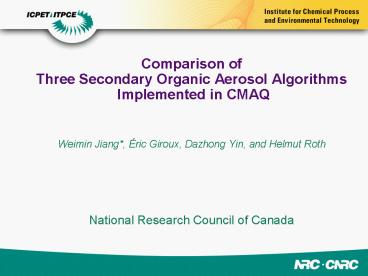Comparison of Three Secondary Organic Aerosol Algorithms Implemented in CMAQ - PowerPoint PPT Presentation
1 / 16
Title:
Comparison of Three Secondary Organic Aerosol Algorithms Implemented in CMAQ
Description:
Jiang (2003), Atmos. Environ. ( in press) 14. OAY or IAY: A big deal? ... Program of Energy Research and Development (PERD) in Canada: Funding support. 16. Thank you ! ... – PowerPoint PPT presentation
Number of Views:23
Avg rating:3.0/5.0
Title: Comparison of Three Secondary Organic Aerosol Algorithms Implemented in CMAQ
1
Comparison of Three Secondary Organic Aerosol
Algorithms Implemented in CMAQ
- Weimin Jiang, Éric Giroux, Dazhong Yin, and
Helmut Roth - National Research Council of Canada
2
Outline
- SOA calculation in CMAQ
- The three CMAQ SOA algorithms
- Model set-up
- Impact on organic aerosol modelling results
- spatial, temporal, SOA/fine ratios, algorithm
correlations - Impact on organic aerosol modelling performance
- comparison with measurements
- Conclusions and discussion
3
SOA calculation in CMAQ
- Three major steps
- Steps 1 and 3 Binkowski and Roselle (2003)
Binkowski and Shankar (1995) US EPA (1999) - Implementation details Jiang and Roth (2003)
- Step 2 SOA algorithm to calculate SOA mass
formation rate.
4
Three CMAQ SOA algorithms
- Pandis constant AYs for 6 pseudo SOA precursor
species - Odum AYs for 4 pseudo species from
- Schell system of equations for 10 condensable
species derived from 6 pseudo species, with T
correction for gas phase saturation
concentrations
5
Model set-up the model
- Base model CMAQ 4.1
- Modularized AERO2 by NRC (Jiang and Roth, 2002)
- Schell extracted from AERO3 in CMAQ 4.2 and
converted to a submodule in AERO2 - Three CMAQ executables different only in SOA
submodule all other science and code the same
6
Modularized aerosol module
7
Model set-up domain, period, inputs
- Nested LFV domain, Pacific 93 episode (July 31
August 7, 1993) see H. Roths presentation - All model inputs are the same except for organic
aerosol species - clean IC and BC for the study of algorithm impact
on modeling results - observation-base IC and BC for the study of
algorithm impact on model performance
8
Impact on spatial distribution
9
Impact on temporal variation
10
Impact on model performance
11
Conclusions and discussion
Schell Pandis
Odum Science best among three
simplified not usable SOA-generation n
x Pandis 10n x Odum very
low performance good on average
underestimate dramatic
underestimate Note wide range of
norm.bias Deficiency/problem no partitioning of
org. OAY, not IAY aerosol to gas
phase ? overestimate SOA (corrected in
CMAQ 4.3?)
12
Odum algorithm problem OAY vs. IAY
- OAY Overall AY
- average AY
- from DROG0 and M00
- to DROG DROG and M0M0
- IAY Instantaneous AY
- AY at DROG and M0
13
OAY equation vs. IAY equation
- Jiang (2003), Atmos. Environ. (in press)
14
OAY or IAY A big deal?
Yes, a big deal both conceptually and
quantitatively.
15
Acknowledgment
- US EPA Original Models3/CMAQ
- Environment Canada Pollution Data Branch, Air
Quality Research Branch, Pacific Yukon Region - Raw emissions and ambient measurement data
- Dr. D. G. Steyn of the University of British
Columbia Pacific 93 data set - Program of Energy Research and Development (PERD)
in Canada - Funding support
16
Thank you !































